Previewing Silicon Motion SM2260 NVMe Controller With 3D MLC NAND (512GB)
by Billy Tallis on February 17, 2017 9:00 AM ESTRandom Read Performance
The random read test requests 4kB blocks and tests queue depths ranging from 1 to 32. The queue depth is doubled every three minutes, for a total test duration of 18 minutes. The test spans the entire drive, which is filled before the test starts. The primary score we report is an average of performances at queue depths 1, 2 and 4, as client usage typically consists mostly of low queue depth operations.
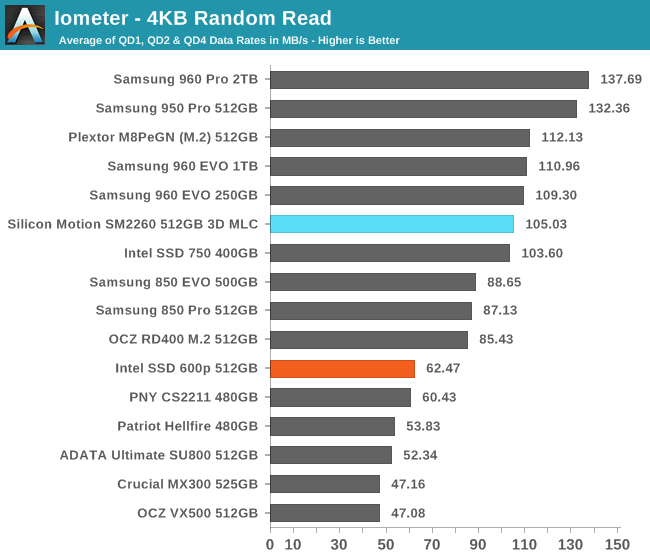
The SM2260 sample delivers random read performance that is on par with most of its competitors, both vetter than any SATA SSD and notably better than the Patriot Hellfire, OCZ RD400 and Intel SSD 600p NVMe SSDs.
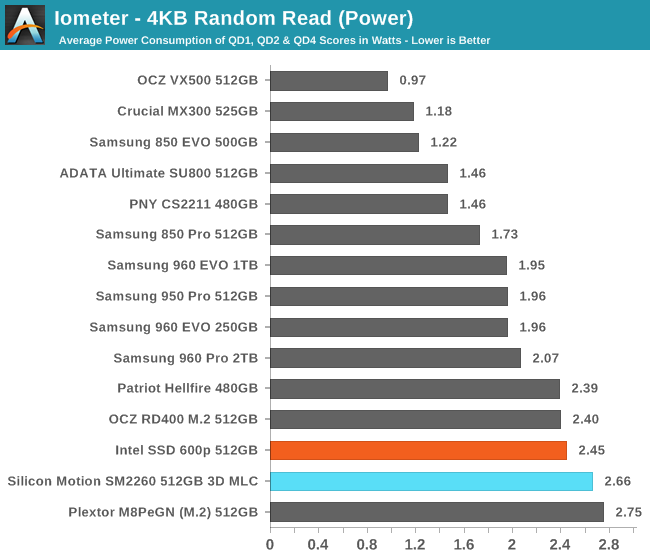
The SM2260 sample delivers random read performance that is on par with most of its competitors, both vetter than any SATA SSD and notably better than the Patriot Hellfire, OCZ RD400 and Intel SSD 600p NVMe SSDs.
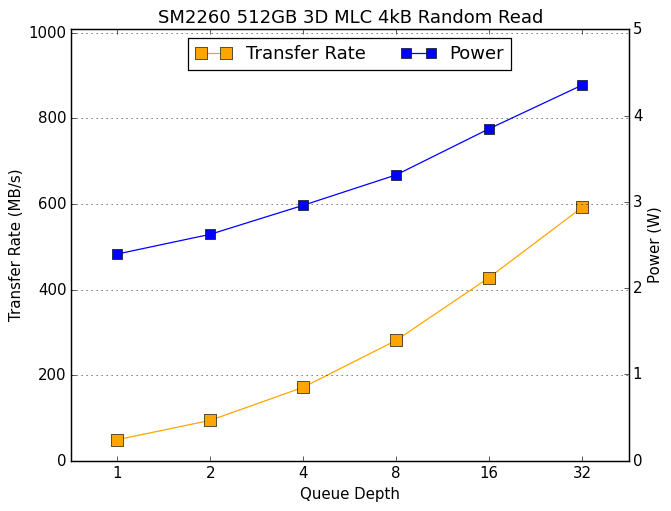 |
|||||||||
The SM2260 scales to much higher performance at higher queue depths than the Patriot Hellfire, but doesn't hit quit as high a peak as the rest of the MLC NVMe SSDs, some of which are also near full speed at QD16.
Random Write Performance
The random write test writes 4kB blocks and tests queue depths ranging from 1 to 32. The queue depth is doubled every three minutes, for a total test duration of 18 minutes. The test is limited to a 16GB portion of the drive, and the drive is empty save for the 16GB test file. The primary score we report is an average of performances at queue depths 1, 2 and 4, as client usage typically consists mostly of low queue depth operations.
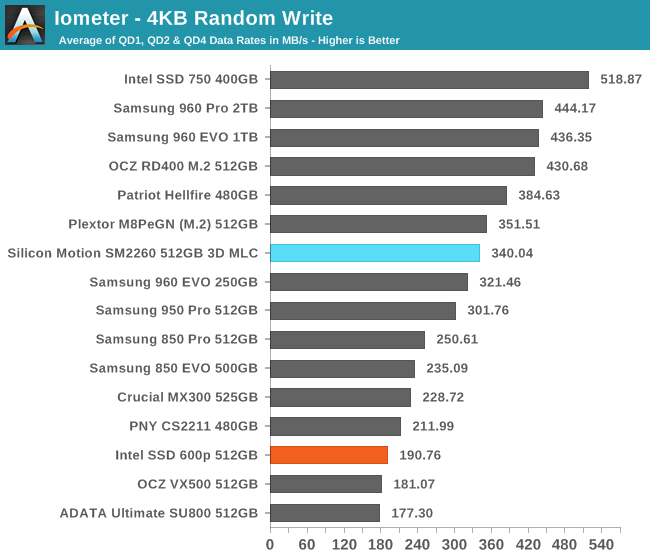
The SM2260 sample delivers better random write performance than Samsung's 950 PRO, but it can't match the more recent MLC-based NVMe SSDs.
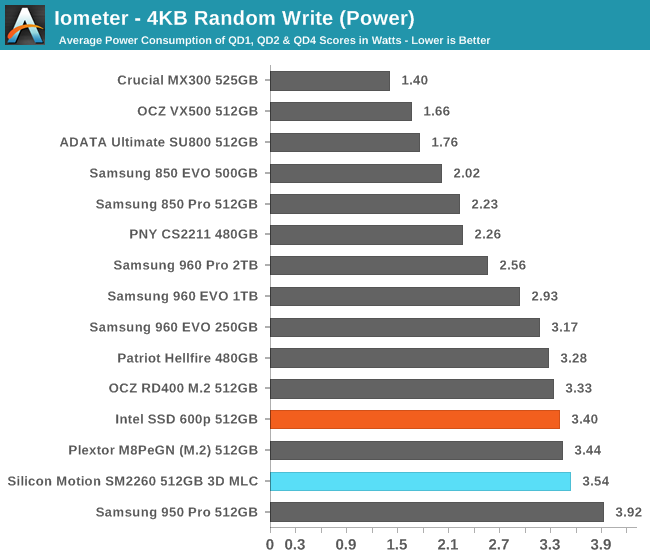
The SM2260 also beats the Samsung 950 PRO on power consumption and efficiency, but against the more recent competition it fares poorly.
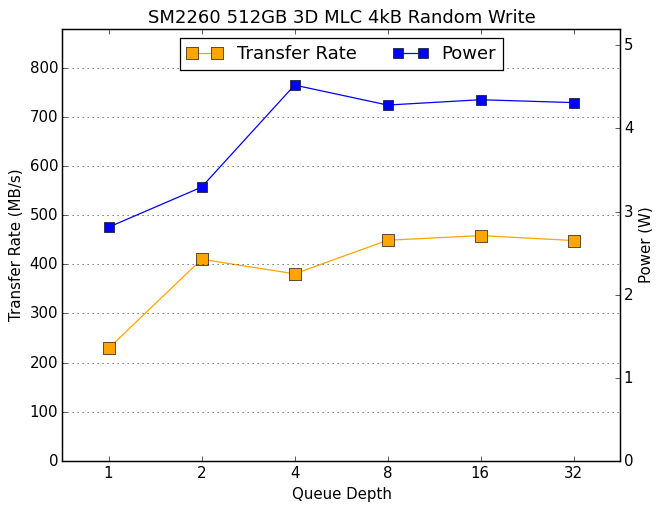 |
|||||||||
Performance scaling for the SM2260 is rough as it runs out of SLC cache and potentially begins to thermally throttle as the test progresses to higher queue depths. Its average of around 450 MB/s during the second half is substantially less than what most of its closest competitors manage even when they are thermally limited.










27 Comments
View All Comments
romrunning - Friday, February 17, 2017 - link
You would have thought their design performance target would have been the older 950 Pro (not the newer 960 line) or the even-older Intel 750 . But no, it seems they are competing with Phison for the lowest-performing NVMe SSD award. Disappointing - just like that Intel 600p.ddriver - Friday, February 17, 2017 - link
First look: slow. Second look: still slow. It is quite the feat they manage to make an nvme controller almost as slow as sata.jjj - Friday, February 17, 2017 - link
Guess it's a sub 200$ drive, we'll see how it does against WD's offering and Plextor M8Se.Not worth wasting the M.2 slot on such a drive, unless it's well bellow 200$. Right now on Newegg, the M8Pe without a shield is 220$.
kissiel - Friday, February 17, 2017 - link
Isn't the Z97Pro bottlenecking the drive?AFAIK it's pcie2.0 x 2 - > so sub 1GiB/s tops.
revanchrist - Friday, February 17, 2017 - link
True that. It's a 10Gbps M.2 rather than the newer 32Gbps M.2 slot.fanofanand - Friday, February 17, 2017 - link
Nice catch! Strange for one of the top tech sites in the world to use old tech to test new tech. Very strange indeed. Ryan? Can you squeeze Purch to get some current equipment into your reviewer's hands?DanNeely - Friday, February 17, 2017 - link
I don't think so. The last page of the article shows the card in a x4 PCIe adapter. AFAIK that's plugged into 3.0 lanes from the CPU both for performance testing and to monitor the power draw.Billy Tallis - Friday, February 17, 2017 - link
Exactly right. All PCIe SSDs are tested in the PCIe 3.0 x16 slot with a riser card that has the power measurement points on it. Although, I did also test the Intel 600p in the motherboard's M.2 slot to see how much the slowest NVMe drive would be affected.kissiel - Saturday, February 18, 2017 - link
Thanks!Please consider pointing that out in a test bed info next time, so people will know what to expect with a similar combo (z97+m.2).
Keep up, the good work!
TelstarTOS - Friday, February 17, 2017 - link
Another piece of crap. This controller should be trashed away.